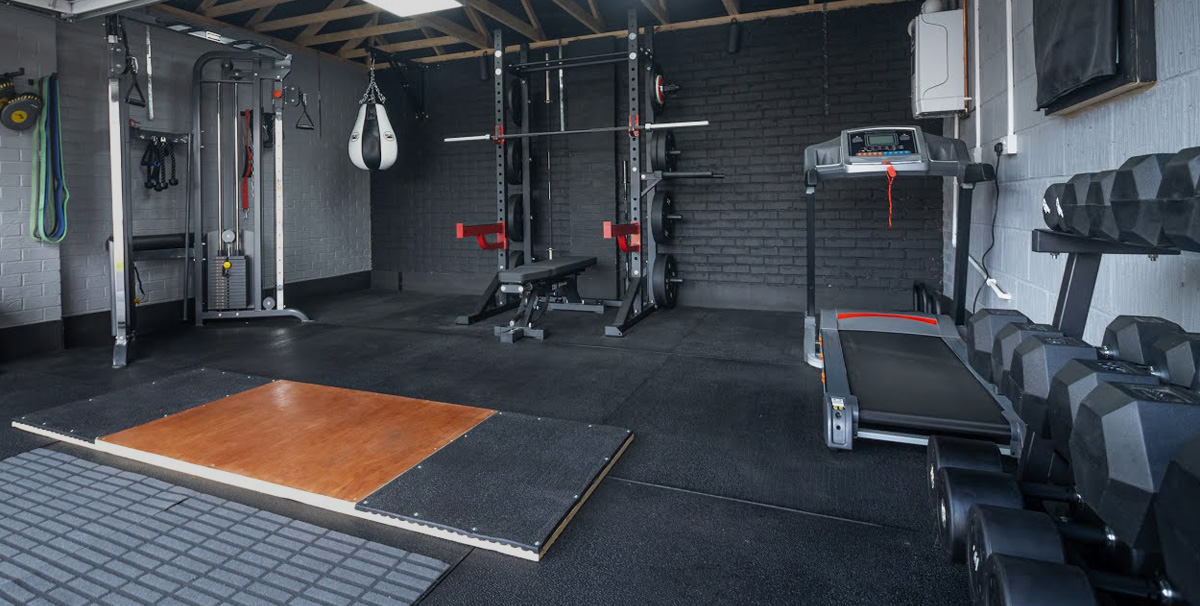Are you considering investing in a home gym? If so, it’s essential to figure out how much space for a home gym you’ll need to accommodate all your workout equipment.
In this post, we’ll take a look at the different factors that will influence your decision-making process. So whether you’re working with a limited budget or have plenty of room to spare, we’ve got you covered!
Weightlifting set up with the necessities, such as a bench and dumbbells, can easily fit into an area measuring at least 56 sq. ft. (84″ x 96″.) If you want to add more equipment like power racks or barbells, this grows to 101″ x 96″. These measurements are large enough for all your equipment needs, including bodyweight exercises.
| Equipment | Width | Length | Total |
|---|---|---|---|
| Equipment | Width | Length | Total |
| Power rack + Bench + Barbell | 89” | 96” | 59.3 sq. ft. |
| Bench + Dumbbells | 84” | 96” | 55.9 sq. ft. |
| Bench + Dumbbells + Barbell + Rack | 101” | 96” | 67.3 sq. ft. |
| Small Multi-station Gym | 72” | 60” | 29.9 sq. ft. |
| Large Multi-station Gym | 72” | 108” | 53.9 sq. ft. |
| Exercise Bike | 26” | 108” | 53.9 sq. ft. |
| Treadmill | 28” | 48” | 8.6 sq. ft. |
| Rowing Machine | 48” | 64” | 12.4 sq. ft. |
| Elliptical | 30” | 96” | 31.9 sq. ft. |
| Bodyweight Exercises | 48” | 72” | 15 sq. ft. |
Home Gym Equipment Dimensions
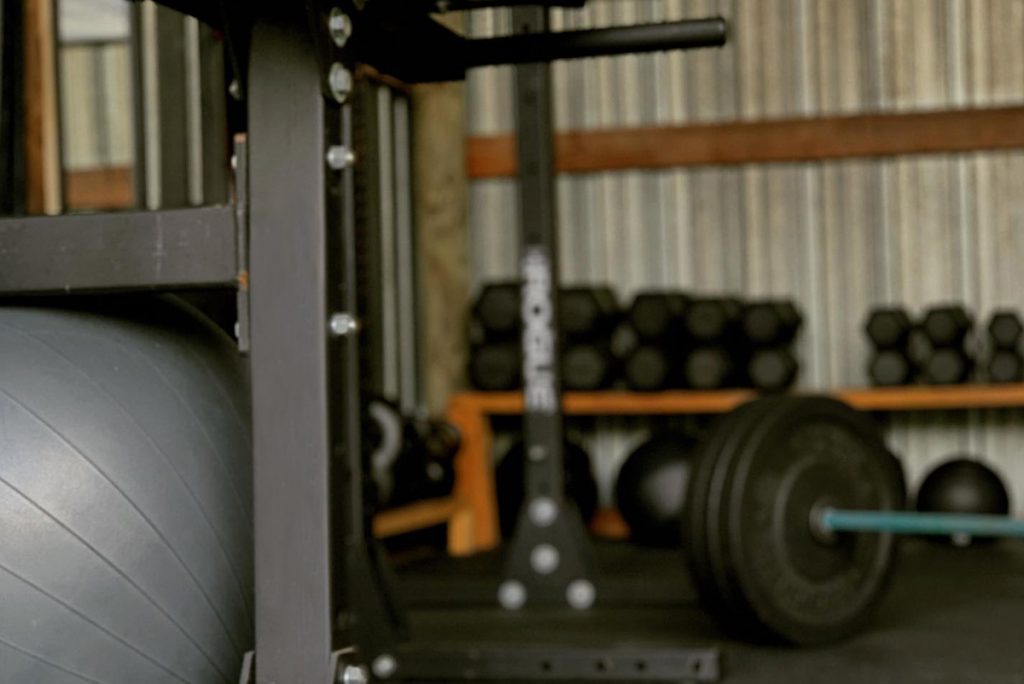
Let’s look at some of the best home gym equipment setups, along with the area dimension you’ll require for them.
Space for Weightlifting
Weightlifting is a necessary part of any workout routine, and it’s also beneficial for fat loss, building muscle, and toning up the body.
If you’re interested in either goal, weight training should be at the top of your list when looking into home gyms.
Before starting this workout routine, the amount of space necessary for your workout needs to be considered, as weightlifting equipment takes up so much room.
Bench Setup and Power Rack
Width
Power racks come in various shapes and sizes, but the universal figure of 4 feet is a good starting point.
Furthermore, a power rack can have large foot or plate storage pegs extending from its frame. When placed on the collars, a typical Olympic barbell lies around 51-52 inches long.
But it’s essential to measure your setup for accurate dimensions before purchasing gym equipment that may not fit. The total length is 7 feet long, and it needs an open space to move freely.
With this setup, you will need enough room for loading plates onto the weight stack and having somewhere comfortable to sit when performing bench presses. The 7-foot bar can be a challenge to handle, especially if you don’t have enough space for both sides.
It’s best practice to give yourself at least 10 feet of clearance when loading the bar on either side. This is so that there are 16 inches between your body and weights coming off it before lifting begins.
A little less will do in a pinch, but try not to load 45 pounds onto this without taking some time out of your day first – who wants their workout cut short?
It is possible to decrease the risk of injury by using a 6 feet bar that has an inside circumference similar in length to other standard weightlifting bars.
This particular type can be found at most stores and comes equipped with sleeves only half as long on each side.
It makes it easier for women who typically struggle when lifting weights overhead because they are shorter than men.
Length
As far as the depth of your area from front to back, you will ideally want enough room that’s just right for sliding in and out.
Add together how long(4-5ft) plus the dimensions on both sides (6 feet). You’ll end up with anywhere between an 8 – 11 feet space.
If this doesn’t work or isn’t possible, it is highly recommended to add a ramp at an angle to roll their benches out easily without obstruction.
Total
A 10 x 7 feet area is enough to get started but if you want more room than that, consider getting an adjustable or flat-top weight training equipment with this setup as well.
Squats Stand and Bench
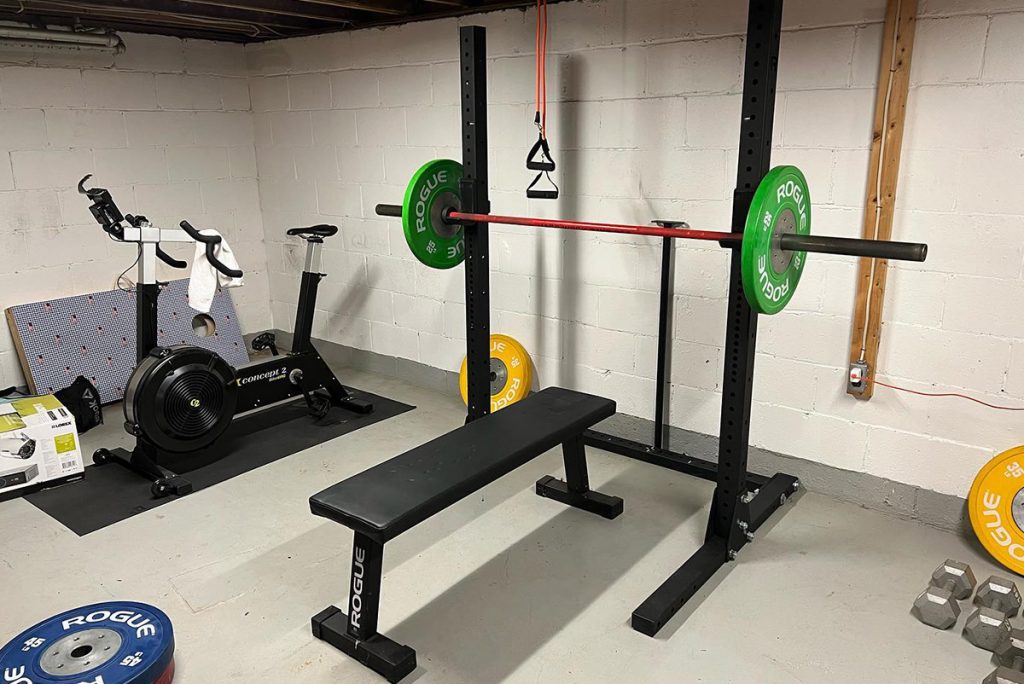
A half-rack or squat stand is an excellent option for those who don’t have the floor space to spare. It can be used in place of your regular power racks and still offer stability when exercising heavyweights on its front side.
The smaller footprint of this half rack gives you more room to work due to how it angles uprights.
Unlike a power rack, which may have 12 inches or so required for wall clearance depending on what’s installed in front of it – as long as there isn’t anything blocking off its entrance – this one can go right up against an interior surface with no problem at all.
Squat stands are great for compact spaces because they can be used in smaller areas than traditional squat racks. A 10′ x 5′ place might not have much room, but you’ll still be able to fit a bench and weight plate on top.
The small-footprint models will only take up 26 inches of depth, so it’s easy enough if your home gym doesn’t have too many square feet available.
Dumbbells, Bench, and Power Rack
Dumbbell workouts on a bench can be done with enough space if you have the right equipment and know-how. You’ll need plenty of room for your arms.
So, it’s essential that any 6ft x 7ft area is adequate to accommodate all necessary movement to do this safely without bumping into anything.
A 4′ long bench might not provide enough length. But don’t worry because there are always alternatives, such as using an adjustable power rack where these exercises would take place instead.
It gives more versatility when deciding what type(s)of workouts suit one’s needs best based on available resources.
Wall Mounted Squat Rack
This new type of squat rack is incredibly versatile and easy to move around. It folds up against the wall when it’s not in use, taking mere inches from your floor space.
Pop-out a pin on either side – there’ll only be one top bracing or pull-up bar holding these two sides together.
Then remove it so you can fold them inward into themselves for storage options that are perfect if you’re short on living room real estate but still want access all day long.
When installing your rack, you should make sure that the feet are barely touching or hanging off the floor by just enough. When weight is put on them, they transfer most of it over.
You don’t want any dragging caused by hard floors since this can damage items placed against a wall mount for storage purposes! Rogue makes one in 21 5/8-inch tall (for small spaces) & 41 1/4-inch heights.
These would work great here because we’re trying not to waste too many inches out front.
Space for Cardio Machines
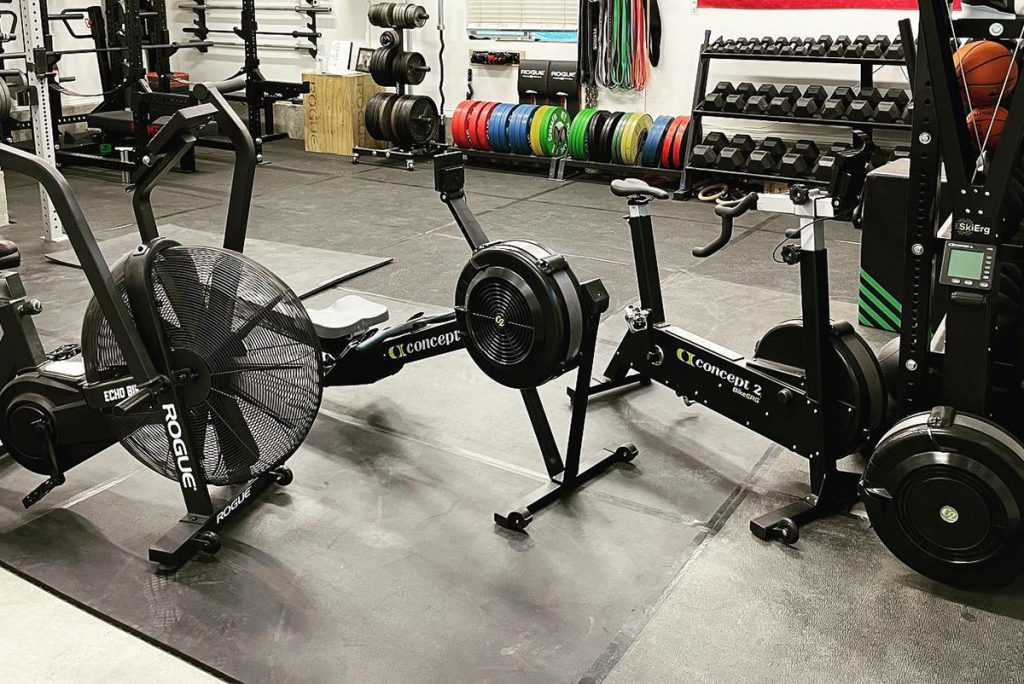
The best thing to do when shopping for a cardio machine is to measure the space you have. This will help ensure that nothing gets overlooked and that the machine you choose can fit within its own real estate.
This means more extra room on top of things. Just like with weightlifting equipment, there’s plenty out there.
But each one has different features, so take some time to figure out what exactly works well before buying.
Many different types of cardio equipment exist with varying models and sizes. To begin with, the workout space in your home gym is an important consideration.
The average dimensions are broken down into different categories so you can find the perfect size for what suits you best!
If you’re looking for a cardio machine for your home gym, this is what your average footprint will look like.
Commercial versions tend to be more extensive and robust in design, resulting in different dimensions, but these are just guidelines.
Always check the measurements of any gym equipment before purchasing it.
- Treadmill – The average length is 64-inch and width 28-inch
- Rowing Machine – The average length is 72-inch
- Exercise Bikes – The average length is 35-48 -inch, and width are 18-26-inch
- Elliptical – The average length is 72-inch and width is 30-inch
How Much Space Needed to Exercise?
If you’re looking to get in some quality bodyweight exercises but don’t want the hassle of investing money or time into other gym equipment, there’s no need for a full-fledged home gym.
Just grab your favorite yoga mat, and some open space should be enough to perform various exercises. You could even use resistance bands if needed – they work just as well anywhere.
That being said, if you want to do bodyweight workouts and use equipment as well, it is essential that you know how much space is available that will suit your needs.
Many of these moves can be done comfortably with just one small area and don’t require much room at all. Airtight lunges, step-ups, bodyweight squats, box jumps, etc., will work up a sweat in tight spaces while standing straight without having too far around them or overhead.
You can do these exercises in a small space. How much space do you need? A 4’x5′ area of free space is enough to perform the workouts comfortably without needing more than that.
For some other bodyweight exercises such as glute bridge, push-ups, crunches, and burpees, you’ll need to be horizontal.
For such exercises, you’ll need a space at least 1 or 2 feet longer than your height. This is because if it’s the same as your height, then bumping into walls will happen.
Plus, movement during exercise can cause worry about accidentally hitting the head with full force – which isn’t suitable for us.
For instance, if you’re 6 feet tall, you should use an 8 feet long free area as their target spot. A space of 4 feet wide is ideal for performing most bodyweight workouts, but a little bit wider would make it more comfortable.
List of Small Space Exercises
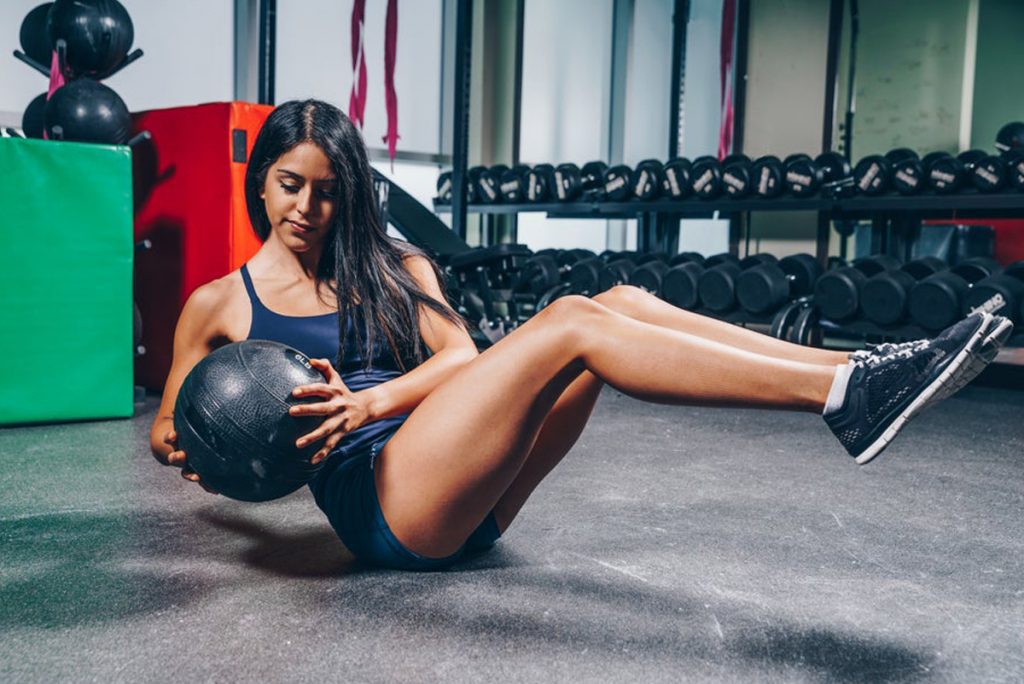
Below are some of the small space workouts you can try in your home gym for yourself.
- Overhead Reach – The overhead reach is a great exercise to do if you’re looking for a total-body workout. This exercise works your shoulders, chest, and triceps.
- Trunk Twist – A trunk twist is a great way to work your abs. It’s simple to do – all you need is a mat or a soft surface to lie on.
- Mountain Climber – A mountain climber is a plank variation that you can do on the ground or a stability ball. It’s a full-body workout that engages your core, back, arms, and legs equally.
- High-Knee Sprint – A high-knee sprint is a running exercise where you sprint while lifting your knees as high as possible. This can be a great exercise to improve your speed and agility.
- Standing Oblique Crunch – A standing oblique crunch is an exercise that works your abs. It’s a great way to tone your midsection and improve overall fitness. This exercise can be done in a tiny apartment with little space required.
- Frog Jump – A frog jump is a weight training exercise that primarily targets the hip flexors. It can also help strengthen the arms, shoulders, chest, core, and buttocks.
- Single-Leg Burpee – A single-leg burpee is a variation of the traditional burpee that requires you to make all the motions of a burpee on one leg. The single-leg burpee is an excellent way to work your abs, glutes, and hamstrings.
- Prisoner Squat – A prisoner squat is a bodyweight exercise where you squat down as low as possible and then stand back up. This exercise is a great way to work your thighs, glutes, and hips.
- Seated Twist – A seated twist is a stretch that involves the spine and torso. The exercise provides more stretching to your mid-back muscles and may relieve minor back pain.
- Push-Up – A push-up is a common strength training exercise in which the individual pushes their body weight from a prone position up off of the ground by straightening the arms.
Small Space Saving Equipment
Let’s look at some of the best workout equipment for small spaces.
Adjustable Dumbbells
Adjustable dumbbells are a good investment for someone who wants to do a lot of different exercises that require heavyweights.
The dumbbells are large enough to hold many weights but can also be adjusted for lighter activities. They take up very little space; hence they are perfect for a small home gym.
Folding Bench
A folding bench is a type of exercise equipment that allows you to do a wide variety of exercises. It is typically made of steel and can be folded up for easy storage.
A folding bench is an excellent piece of equipment to have if you don’t have a lot of space in your home gym.
Resistance Bands
Another space saver for a small home gym is a resistance band. Resistance bands can be used to do a lot of different exercises, including squats, lunges, and bicep curls. They are also very compact and can easily be stored in a drawer or closet.
Exercise Ball
Exercise balls can be used for various exercises that work different parts of your body. One great way to use an exercise ball is to place it between your back and a wall and do squats, and this will work your glutes and hamstrings.
You can also set the ball between your feet and do crunches to work your abs.
Folding Power Rack
A folding power rack is an excellent piece of equipment to have in a small space. It’s easy to set up and takedown, and it doesn’t take up a lot of room.
A power rack offers you the ability to work out safely without a spotter. If you don’t have a lot of space, a folding power rack is a great way to work out.
Folding Treadmill/Rower
One of the ways to exercise in a small space is to have a folding treadmill or rower. This would be something you would need to store away to take up floor space all the time. This may not be a bad option if you have a small exercise area.
Wrapping Up
Don’t let your lack of space keep you from staying healthy and fit. There are plenty of ways to get around the problem with a bit of ingenuity!
It would help if you had the right equipment, plus some creativity when it comes time for planning out your workout area in advance so that you can have an effective routine every day.
